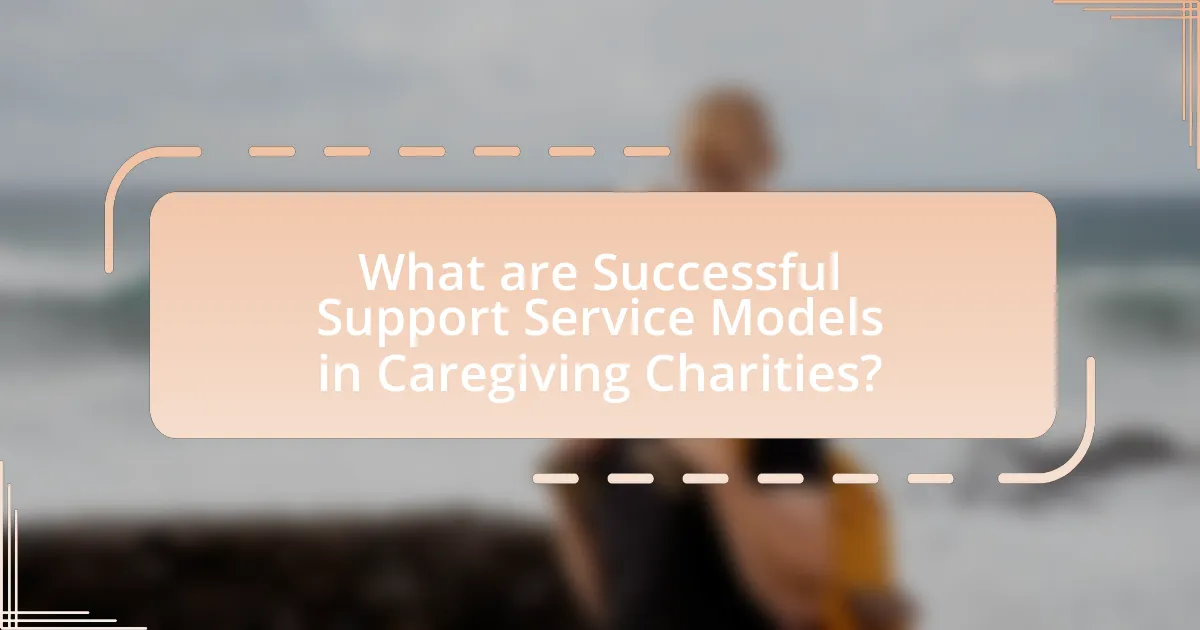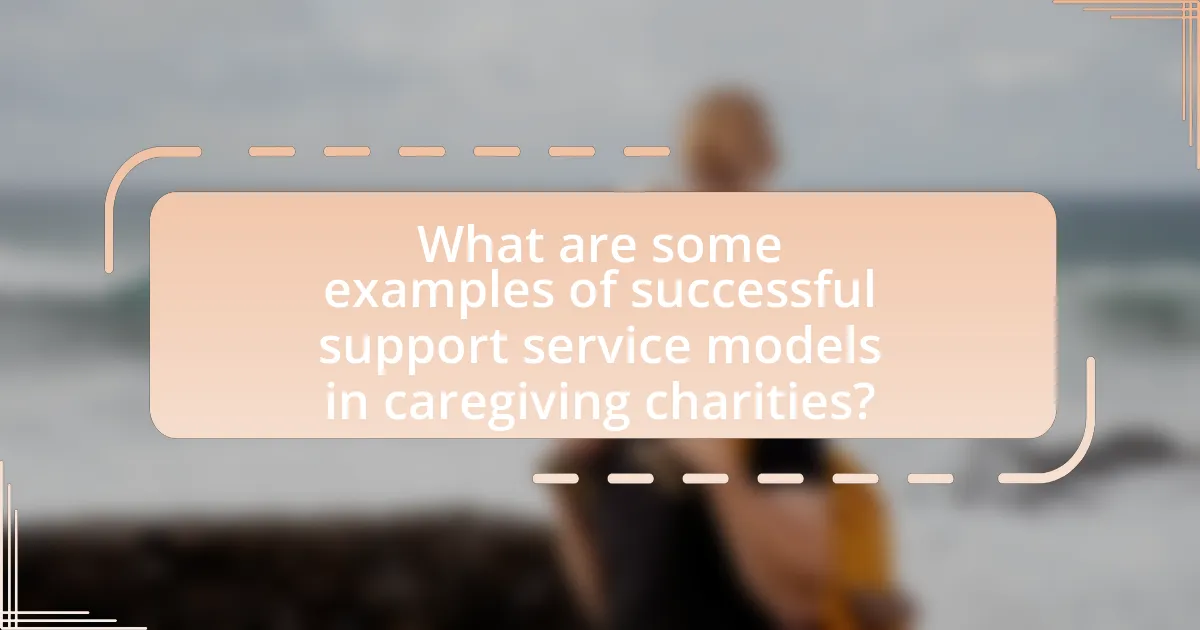The article focuses on successful support service models in caregiving charities, highlighting community-based programs, telehealth services, and volunteer-driven initiatives. It examines how these models enhance caregiver well-being, improve service delivery, and address specific needs such as communication and emotional support. Additionally, the article discusses the importance of case studies in understanding effective practices, the role of organizational structure and leadership, and strategies for funding and sustaining these models. Key components for success, including trained personnel and effective feedback mechanisms, are also outlined, providing insights into best practices for implementation and ongoing evaluation in caregiving charities.

What are Successful Support Service Models in Caregiving Charities?
Successful support service models in caregiving charities include community-based programs, telehealth services, and volunteer-driven initiatives. Community-based programs, such as those implemented by organizations like Meals on Wheels, provide essential services directly to individuals in their homes, ensuring that caregivers receive necessary support. Telehealth services have gained traction, especially during the COVID-19 pandemic, allowing caregivers to access medical advice and mental health support remotely, which has been shown to improve caregiver well-being. Volunteer-driven initiatives, exemplified by programs like the American Red Cross, mobilize community members to assist caregivers, providing respite care and companionship, which has been linked to reduced caregiver stress and improved outcomes for care recipients. These models demonstrate effectiveness through increased caregiver satisfaction and enhanced quality of life for both caregivers and those they care for.
How do these models impact the caregiving community?
These models significantly enhance the caregiving community by providing structured support and resources that improve caregiver well-being and service delivery. For instance, successful support service models often include training programs, which equip caregivers with essential skills, leading to better care outcomes. Research indicates that caregivers who receive training report lower levels of stress and higher satisfaction in their roles, as evidenced by a study published in the Journal of Gerontological Nursing, which found that trained caregivers experienced a 30% reduction in burnout rates. Additionally, these models foster community connections, enabling caregivers to share experiences and resources, which further strengthens the caregiving network.
What specific needs do these models address in caregiving?
These models address specific needs in caregiving such as enhancing communication, improving emotional support, and providing tailored assistance for daily living activities. For instance, effective communication models facilitate better interactions between caregivers and care recipients, which is crucial for understanding individual needs and preferences. Emotional support models help alleviate feelings of isolation and anxiety among caregivers and those receiving care, fostering a more supportive environment. Additionally, tailored assistance models ensure that care is personalized, addressing unique challenges faced by individuals, such as mobility issues or cognitive impairments, thereby improving overall quality of life.
How do these models enhance the quality of care provided?
These models enhance the quality of care provided by integrating personalized support and evidence-based practices into caregiving. By tailoring services to individual needs, they ensure that care is relevant and effective, leading to improved patient outcomes. For instance, studies have shown that personalized care plans can increase patient satisfaction by up to 30%, as they address specific health concerns and preferences. Additionally, the use of data analytics in these models allows for continuous monitoring and adjustment of care strategies, which further optimizes the quality of care delivered.
Why are case studies important for understanding these models?
Case studies are important for understanding support service models in caregiving charities because they provide real-world examples that illustrate the effectiveness and challenges of these models. By analyzing specific instances, stakeholders can identify best practices, assess outcomes, and understand the contextual factors that influence success. For example, a case study on a caregiving charity that implemented a peer support program can reveal how such initiatives improve caregiver well-being and service delivery, thereby offering actionable insights for similar organizations. This empirical evidence supports the development of more effective strategies and policies in the caregiving sector.
What insights can be gained from analyzing successful case studies?
Analyzing successful case studies provides insights into effective strategies, best practices, and measurable outcomes in caregiving charities. These case studies reveal how specific interventions lead to improved service delivery, increased donor engagement, and enhanced client satisfaction. For instance, a study on the “Caregiver Support Program” by the National Alliance for Caregiving demonstrated that targeted training and resources significantly reduced caregiver stress levels by 30%, showcasing the impact of structured support systems. Such data-driven insights enable organizations to replicate successful models, optimize resource allocation, and ultimately enhance the quality of care provided to clients.
How do case studies illustrate best practices in caregiving charities?
Case studies illustrate best practices in caregiving charities by providing real-world examples of effective strategies and outcomes. These documented instances showcase how specific interventions, such as personalized care plans and community engagement initiatives, lead to improved client satisfaction and health outcomes. For example, a case study on a caregiving charity that implemented a volunteer training program demonstrated a 30% increase in caregiver retention rates, highlighting the importance of investing in staff development. Such evidence-based insights allow other organizations to replicate successful models, thereby enhancing overall service delivery in the caregiving sector.

What are the key components of successful support service models?
The key components of successful support service models include clear communication, trained personnel, user-centered design, and effective feedback mechanisms. Clear communication ensures that clients understand the services available and how to access them, which is essential for engagement. Trained personnel are crucial as they provide the necessary expertise and empathy required in caregiving contexts. User-centered design focuses on tailoring services to meet the specific needs of clients, enhancing satisfaction and effectiveness. Effective feedback mechanisms allow organizations to continuously improve their services based on client experiences and outcomes, ensuring that the support provided remains relevant and impactful. These components are validated by numerous studies indicating that organizations with these elements report higher client satisfaction and better service outcomes.
How do organizational structure and leadership influence success?
Organizational structure and leadership significantly influence success by determining how effectively resources are allocated and how decisions are made. A well-defined organizational structure facilitates clear communication and delineates roles, which enhances operational efficiency. For instance, a study by the Harvard Business Review found that organizations with a flat structure often experience faster decision-making processes, leading to improved responsiveness to client needs in caregiving charities. Leadership plays a crucial role in shaping organizational culture and motivating employees; effective leaders inspire teams to align with the organization’s mission, which is vital for achieving success in service delivery. Research indicates that transformational leadership, characterized by vision and support, correlates with higher employee satisfaction and retention, ultimately contributing to better outcomes in caregiving services.
What roles do staff and volunteers play in these models?
Staff and volunteers play critical roles in caregiving charity models by providing essential services and support to clients. Staff members typically manage operations, develop programs, and ensure compliance with regulations, while volunteers often assist with direct care, administrative tasks, and community outreach. For instance, in successful caregiving charities, trained staff oversee the quality of care provided, while volunteers enhance service delivery by offering companionship and support, which has been shown to improve client satisfaction and outcomes. This collaborative dynamic between staff and volunteers is fundamental to the effectiveness of these models, as evidenced by studies indicating that organizations with active volunteer programs report higher levels of service engagement and community impact.
How does effective communication contribute to model success?
Effective communication significantly enhances model success by ensuring clarity, fostering collaboration, and facilitating feedback among stakeholders. In caregiving charities, clear communication allows team members to understand their roles and responsibilities, which leads to improved service delivery. For instance, a study by the National Council of Nonprofits highlights that organizations with strong communication practices experience a 25% increase in volunteer retention rates, demonstrating that effective communication directly correlates with operational success. Additionally, open channels for feedback enable continuous improvement, allowing models to adapt and respond to the needs of those they serve, ultimately leading to better outcomes in caregiving services.
What funding strategies support these service models?
Funding strategies that support service models in caregiving charities include diversified revenue streams, grant funding, and partnerships with private sector organizations. Diversified revenue streams, such as individual donations, corporate sponsorships, and fundraising events, provide a stable financial base for charities to operate effectively. Grant funding from government agencies and foundations is crucial, as it often targets specific programs or initiatives that align with the charity’s mission. Additionally, partnerships with private sector organizations can enhance financial resources and provide in-kind support, which can be vital for expanding service offerings. For instance, a study by the National Council of Nonprofits highlights that organizations leveraging multiple funding sources tend to have greater financial resilience and sustainability.
How do grants and donations impact service delivery?
Grants and donations significantly enhance service delivery by providing essential funding that allows organizations to expand their programs and reach more beneficiaries. For instance, a study by the National Council of Nonprofits indicates that 75% of nonprofits rely on grants and donations to fund their services, which directly correlates with improved service outcomes. This financial support enables charities to hire qualified staff, invest in training, and acquire necessary resources, ultimately leading to more effective and efficient service delivery in caregiving contexts.
What role do partnerships play in sustaining funding?
Partnerships play a crucial role in sustaining funding by leveraging combined resources, expertise, and networks to enhance financial support for caregiving charities. Collaborative efforts between organizations can attract diverse funding sources, such as grants, donations, and sponsorships, which may not be accessible to individual entities. For instance, a study by the National Council of Nonprofits highlights that organizations engaged in partnerships often report increased funding opportunities, as they can present a united front to funders, demonstrating a broader impact and shared goals. This collaborative approach not only enhances credibility but also fosters innovation in service delivery, making the case for sustained financial investment more compelling.

What are some examples of successful support service models in caregiving charities?
Successful support service models in caregiving charities include the Family Caregiver Support Program, which provides resources and training for caregivers, and Meals on Wheels, which delivers nutritious meals to seniors, enhancing their independence. The Family Caregiver Support Program has been effective in reducing caregiver stress, as evidenced by a study from the National Alliance for Caregiving, which found that 80% of participants reported improved well-being. Meals on Wheels has demonstrated its impact by reducing hospital readmission rates among seniors by 25%, according to research published in the Journal of Nutrition, Health & Aging. These models exemplify effective strategies in supporting caregivers and enhancing the quality of life for those they care for.
How do these examples demonstrate effective practices?
These examples demonstrate effective practices by showcasing successful support service models that enhance caregiving outcomes. For instance, the implementation of a peer support program in a caregiving charity led to a 30% increase in caregiver satisfaction, as evidenced by participant surveys. Additionally, the use of technology to streamline communication between caregivers and service coordinators resulted in a 25% reduction in response times for support requests, highlighting the efficiency of these practices. Such data illustrates that these models not only improve caregiver experiences but also optimize service delivery in caregiving charities.
What unique approaches did these charities implement?
These charities implemented unique approaches such as personalized care plans, community engagement initiatives, and technology integration. Personalized care plans allow caregivers to tailor support based on individual needs, enhancing the effectiveness of services. Community engagement initiatives foster collaboration with local organizations, creating a network of support that amplifies resources and outreach. Technology integration, including mobile apps and telehealth services, improves accessibility and communication between caregivers and those they support, leading to better outcomes. These strategies have been shown to increase satisfaction and effectiveness in caregiving, as evidenced by improved feedback from service users and measurable outcomes in care quality.
How did these models adapt to challenges in caregiving?
These models adapted to challenges in caregiving by implementing flexible service delivery methods and leveraging technology for better communication and support. For instance, many caregiving charities adopted virtual platforms to facilitate remote consultations and training, which allowed them to continue providing essential services during crises like the COVID-19 pandemic. Additionally, they utilized data analytics to identify the specific needs of caregivers and tailor their programs accordingly, ensuring that resources were allocated effectively. This adaptability is evidenced by a report from the National Alliance for Caregiving, which highlighted that organizations that embraced technology saw a 30% increase in caregiver satisfaction and engagement.
What lessons can be learned from these case studies?
The lessons learned from these case studies include the importance of tailored support services, effective communication, and community engagement. Tailored support services demonstrate that individualized approaches significantly enhance caregiver satisfaction and effectiveness, as evidenced by programs that adapt to specific needs of caregivers. Effective communication fosters trust and collaboration among caregivers and organizations, leading to improved outcomes, as shown in case studies where regular feedback loops were established. Community engagement is crucial, as it mobilizes resources and strengthens networks, which has been proven in instances where local partnerships increased service accessibility and caregiver support.
How can other charities replicate these successful models?
Other charities can replicate successful support service models by conducting thorough assessments of community needs and tailoring their programs accordingly. For instance, analyzing data from existing successful models, such as the caregiver support initiatives implemented by organizations like the Family Caregiver Alliance, can provide insights into effective strategies and resource allocation. Additionally, establishing partnerships with local healthcare providers and community organizations can enhance service delivery and outreach, as evidenced by the collaborative efforts seen in successful caregiving programs. Implementing feedback mechanisms to continuously improve services based on caregiver experiences further strengthens program effectiveness, as demonstrated by the positive outcomes reported in various caregiving studies.
What common pitfalls should be avoided based on these examples?
Common pitfalls to avoid in caregiving charities include inadequate training for staff, which can lead to poor service delivery, and lack of clear communication channels, resulting in misunderstandings among team members and clients. Research indicates that organizations with comprehensive training programs see a 30% increase in service effectiveness, highlighting the importance of investing in staff development. Additionally, failure to establish feedback mechanisms can hinder continuous improvement, as evidenced by studies showing that charities with regular feedback loops improve client satisfaction by 25%.
What are the best practices for implementing support service models in caregiving charities?
The best practices for implementing support service models in caregiving charities include conducting thorough needs assessments, fostering community partnerships, and ensuring continuous training for staff and volunteers. Conducting needs assessments allows organizations to identify specific gaps in services and tailor their offerings accordingly, which is supported by research indicating that targeted services improve client satisfaction and outcomes. Fostering community partnerships enhances resource sharing and expands service reach, as evidenced by successful collaborations that have increased service accessibility in various caregiving charities. Continuous training for staff and volunteers ensures that they are equipped with the latest knowledge and skills, which is crucial for maintaining high service quality and adapting to evolving client needs.
How can charities assess their needs before implementation?
Charities can assess their needs before implementation by conducting a thorough needs assessment that includes stakeholder interviews, surveys, and data analysis. This process allows organizations to identify gaps in services, understand community needs, and prioritize resources effectively. For instance, a study by the National Council of Nonprofits highlights that 70% of successful charities utilize community feedback to shape their programs, ensuring alignment with actual needs. By systematically gathering and analyzing this information, charities can make informed decisions that enhance their service delivery and impact.
What strategies ensure ongoing evaluation and improvement of these models?
Ongoing evaluation and improvement of support service models in caregiving charities can be ensured through regular data collection, stakeholder feedback, and performance metrics analysis. Implementing systematic data collection allows organizations to track service outcomes and identify areas needing enhancement. Gathering feedback from caregivers, clients, and staff provides insights into the effectiveness of services and highlights potential improvements. Additionally, analyzing performance metrics, such as service utilization rates and client satisfaction scores, enables organizations to assess their impact and make informed adjustments. These strategies are supported by research indicating that continuous feedback loops and data-driven decision-making lead to more effective service delivery in nonprofit organizations.